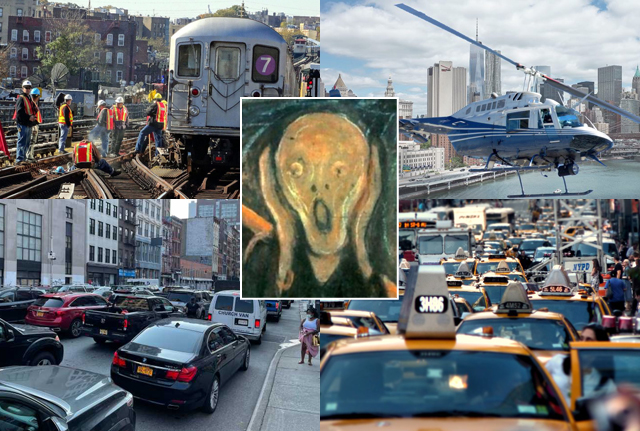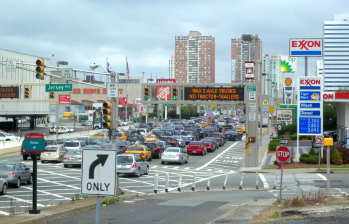Pols Want City Crackdown on Car Noise, But Health Department is Silent

It’s a noisy city, but the silence from the city Department of Health is particularly defeaning.
City Council members were chanting, “Less beeps, more sleeps” last week to pitch their latest effort to hold car drivers accountable for the noise their vehicles emit. And that came after a much-publicized new report revealed yet again that noise from cars is causing increases in heart attacks. That study built on previous research about the role noise plays on stress, which lead to the production of adrenaline and cortisol — which “lead to changes in the composition of our blood and of our blood vessels, which actually have been shown to be stiffer after a single night of noise exposure,” Mathias Basner, a professor at the University of Pennsylvania, once told the 99 Percent Invisible podcast.
The bill, by Council Member Erik Bottcher (D-Chelsea) would increase the penalties for repeat violations of existing violations of the noise code, basically tripling them from the first offense to the third and subsequent. And Council Member Bob Holden (D-Middle Village) has two bills on noise: one would escalate the fines for cars that use exterior speakers to blast their neighbors; the other would escalate the fines “emanating from personal audio devices” (which seems a bit 1980s, but still).
“They’re all good bills and we’re all on the same team about reducing noise,” said a spokesman for Holden.
But there’s long been one player missing from the team: the Health Department — and the agency’s involvement in combating this public health crisis is critical unless the city hopes to enforce its way to peace and quiet (if the NYPD’s efforts on enforcing Vision Zero provides any example, you can’t).
At the presser, Bottcher and Carlina Rivera (D-Lower East Side) said they’ve received no input from the Health Department, which prescribe more pedestrianization, open streets and car-free zones as a treatment for the noise pollution from which we are all suffering.

“The Health Department should be playing a role, and I hope that with the kind of the health focus that the mayor has put forward, plus his focus on street design, we can make what should be health-focused decisions (about streets),” said Rivera, who has a pending bill to create an entire office devoted to protecting pedestrians. “We need to treat noise pollution for the health crisis it is. It causes cardiovascular disease, cognitive impairment, hypertension, hearing loss and countless other adverse effects. Noise pollution does pose a threat to public health, and we have the power to do something about it.”
She cited open streets and the 14th Street busway as evidence that reducing cars leads to quieter, calmer, nicer communities. Or, as “War on Cars” co-host Doug Gordon put it, “Life in the city doesn’t have to be silent, but it doesn’t have to disrupt your health, either.”
And Transportation Alternatives has been on board with quieter streets for years, most recently with its “NYC 25X25” proposal, which calls for 25 percent of road space to be taken away from car drivers and converted for other use, such as pedestrian plazas, wider sidewalks, bike lanes and green space.
“Pairing this legislation with car-free open space, as we’ve outlined in NYC 25X25, will make our streets a healthier place for all,” said senior organizer Juan Restrepo about the Bottcher bill.
Streets as a conduit for something other than traffic — for health, for example — is something that’s being pioneered in Europe. All those pedestrianized city centers (sorry, centres) create zones for recreation and exercise, and keep traffic noise at bay:

London, for example, doesn’t merely seek to create “safe streets” as our Department of Transportation does, but mandates the notion of “healthy streets.” Under the “Healthy Streets for London” program started by Mayor Sadiq Khan in 2016 [PDF], roadways must be designed from a “healthy streets checklist” of 10 indicators of how the road itself could improve physical activity and health.
“It’s for safety for cyclists and drivers, but also to make sure pedestrians are safe from crashes, from anxiety, from noise or even from being discouraged from walking at all,” Andy Summers, transport strategy and planning manager [sustainable modes] for Transport for London, told Streetsblog in 2019.

That public health lens has helped reduce fatalities, which are dramatically lower than New York, even though greater London has a half-million more people.
“A public health approach creates different layers for how we design streets,” Summers said. “We use [crash statistics], of course, but we also look at physical activity data to see where people are inactive or active. And we look at noise. Those are new data layers that we use when designing streets. The goal of the street is to encourage active transport.”
Reporters from Streetsblog have consistently sought to find out what, if anything, the Department of Health and Mental Hygiene has done, is doing, and will do to ensure the health and mental hygiene of New Yorkers who are experiencing toxic levels of noise. We have never gotten an answer.
After Bottcher’s presser last month, we asked another round of basic questions:
- Noise from cars is scientifically proven to be a detriment to human health. What is the Department of Health and Mental Hygiene doing to protect New Yorkers from this health crisis?
- The agency has been accused by activists and local officials, including [two] Council members today, of not doing enough. Can you comment on that?
It has been a year since Streetsblog asked then-Health Commissioner Dave Chokshi if he was “aware of anything that Department of Health has done” to protect New Yorkers from noise. He didn’t have an answer on the spot, but said he would “be happy” to speak with us at length about the topic. We put in an immediate request … and we’re still waiting.
So is Dr. Arline Bronzaft, a noise legend who needs no introduction (but if you need one, click here).
“I would love to know what the health officials are doing about noise, because from my perspective, they are not looking at it,” said Bronzaft, who has worked internationally on noise. “I have not ever worked with the Health Department. I have worked with NYC Transit. I have worked with Council. Five mayors. I worked on the noise code itself in 2007. The one group I have not worked with the the Health Department. They are just so slow on the uptake. We have not gotten the medical world to identify noise as a health problem.”
Neither City Hall nor the Health Department responded to a request for comment.



